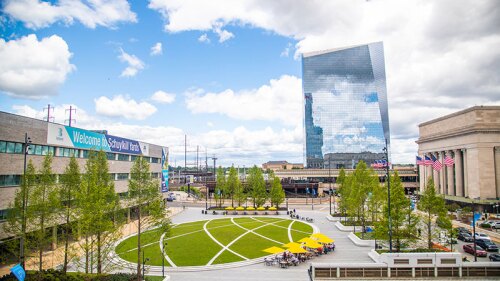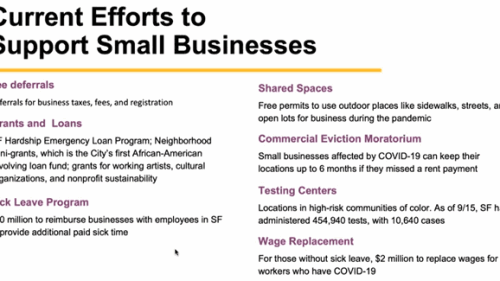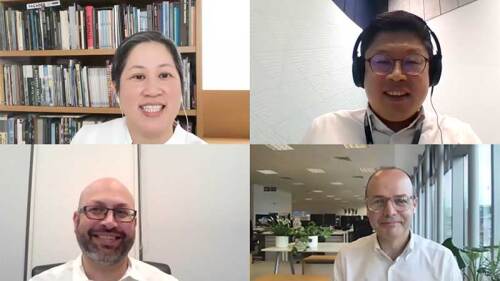The role that health and wellness play in creating resilient buildings and communities has been significantly elevated by the COVID-19 crisis, with healthy design and development strategies becoming key determinants of market competitiveness and investment appeal, according to sustainable real estate experts participating in a webinar hosted by the ULI Center for Sustainability and Economic Performanceand the Institute’s Responsible Property Investment Council(RPIC).
“Resiliency in a New Normal,” moderated by RPIC member Nnenna Lynch, chief executive officer of Xylem Projects in New York City, featured insights from Jonathan Rose, president, Jonathan Rose Companies in New York City; Mark Wilsmann, managing director and head of real estate equities strategies at MetLife Investment Management in Whippany, New Jersey, and a ULI Trustee; and Bradford H. Dockser, chief executive officer of Green Generation in Bethesda, Maryland.
The event was the latest in a series of webinars offered by ULI to explore how the real estate industry is being affected by the virus and the industry’s response. A recording of this webinar is available at ULI’s Knowledge Finder.
Rose, Wilsmann, and Dockser discussed a variety of issues related to how the pandemic has affected their business operations and the industry in general, and how being committed to sustainability and resilience is helping them weather the crisis and plan for a post-virus rebound. The webinar was devoted to questions posed by Lynch to each of the panelists; the following is an excerpt of their responses, edited for clarity and conciseness.
What is your approach to resilience and sustainability and how has it changed in light of COVID-19?
Rose: Our company thinks of resilience and sustainability as having two sides—the green building, energy, and environment side, and the human side. The last time around [during the 2008 economic recession], our greenness was an enormous benefit, because there were fewer green buildings then, and we found that to be a tremendous leasing advantage.
In terms of resilience, all our buildings have generators, and there is a whole series of things we do, such as solar power, to improve energy efficiency.
What lagged behind our environmental sustainability work was human sustainability. We started looking closely at our company culture a couple of years ago, and we realized that our rapidly growing company was creating a high-stress environment.
As a result, we have been working on how to create more human sustainability and resilience. We want to foster a culture of high performance, but we are also focusing much more on well-being. Our offices offer meditation sessions every week, and [since before the coronavirus outbreak] we have been focusing on creating more on digital connections between employees. So, the move out of offices and into working from home went pretty smoothly, because we had the tools in places to do it.
COVID has underscored the importance of the health and well-being of our people and our residents—we are prioritizing health at every level, doing everything we can to keep them healthy.
Wilsmann: We invest on behalf of insurance companies, pension funds, and sovereign wealth funds that have long-term obligations to their constituents; we may be investing with the promise of a payout that does not happen for 20, 30, 40, or 50 years. So, the resilience of our investment program is critical, in terms of being able to deliver on these long-term obligations.
The world of institutional investing is all about how to protect yourself from market risks, operational risks, and event risks. In good times, risk management is considered as a necessary evil—most people want to do deals, and they don’t want to worry about managing exposure and risks. But, when there is a crisis like this one, if you have a good risk management program, it is worth its weight in gold. From an institutional investor standpoint, I think how well you are faring at this stage of the juncture and how well you will fare for the next six months is going to depend on how well you attended to risk management protocols.
Resilience related to climate change is something we have been focused on more recently, and we have also been focused on social inequality issues—the “S” in ESG [environmental, social, and corporate governance]. Certainly, COVID has drawn additional attention to this, in terms of lower-income populations being affected more dramatically by the virus than higher-income populations. And, while we have been prepared for a variety of shocks to the system, I have not come across an institution yet that was well prepared for this pandemic. Some of what we had done [in terms of risk management] can help protect us throughout this process, but we had not specifically addressed the risk of a pandemic like we will going forward.
Dockser: My firm, which is a global energy solutions provider, was born out of the 2008 economic crisis. We have seen tremendous interest over the last few years around the idea of integrating sustainability into the built environment. Sustainability is just good business. It is not just about driving a financial outcome and reducing your expenses for building repair, maintenance, and insurance to drive your cash flows and asset values.
We are also seeing the equity capital markets really demanding that sustainability and resilience be a core part of the business plan for any asset—whether you are developing it, building it, or owning it. People are realizing that an energy conservation plan is key, and if you do not have one, not only is it going to potentially reduce your cash flow, it is going to limit your access to capital markets.
One thing that has changed for us due to COVID is much greater interest from our clients in building health and safety. Historically, this was an asterisk to the conversation. Now, people are saying, “What is WELL [the WELL Building Standard administered by the International WELL Building Institute] and what should we be doing in that regard?” The other thing that has changed is a desire to put the technology that makes buildings healthy and safe front and center to give people confidence (about repopulating buildings).
Rose: One issue I want to mention is uncertainty—we are facing tremendous uncertainty going forward. We are all facing uncertain conditions in coming months regarding how to balance the need for health and social distancing, and the need for people to get back to work. Our company is in the business of affordable housing, and it [the coronavirus crisis] is particularly hard for lower-income and moderate-income people who have far fewer resources.
While there is a lot we can do as individual companies and investors, we are all in this together, and we need to be working together collectively to get through this crisis. This is a role that ULI could make an enormous contribution to by helping us in local, national, and global markets to think about the systemic improvements that are needed [for society to weather the crisis and be more resilient to future crises]. We should be paying attention to what creates a truly resilient world post-COVID.
Have you implemented any resilience tactics previously that better positioned you for this crisis?
Wilsmann: In many ways, this pandemic is a unique challenge. We have managed other risks—terrorism, weather events, climate change through a combination of insurance, portfolio diversification, and exposure mitigation. But with a global pandemic, there are not a lot of places to hide from risks related to that. In terms of the resilience of companies, how you capitalize yourself and retain access to liquidity will determine how you make it through this time. A lesson learned from the global financial crisis is that companies that are overleveraged and have not paid attention to how their debt is structured are in much worse shape now than those that are not overleveraged and have sources of liquidity.
Rose: In 2008, our company was about a tenth of the size it is today, in terms of assets owned. We were more diverse then, doing a great deal of third-party work, both as consultants and in third-party development and management.
This time, we are almost out of the consultant and management business; we are much more focused on our own assets and growing our platform in affordable housing. The interesting thing about affordable housing is that it is tremendously noncorrelated [an investment whose returns are irrespective of market swings]. Because our rents are so much lower than the market rents in cities where we are located, our projects are 100 percent full, with long waiting lists, and that has proven to be an effective strategy for us. We went from diversification to concentration, but we felt that concentration was deeply purposeful and socially necessary.
Dockser: We had spent a lot of time earlier this year investing in information technology resilience—the ability to work remotely. We initiated a trial of the system, the feedback was positive, and when we realized the trial was going to become more permanent, we shipped out monitors and keyboards to people and have been functioning ever since.
In general, what this crisis has exposed is that people generally focus on what is likely to happen, rather than the unlikely events—the section in contracts that most people don’t pay attention to—that is really exposed now. And, we are seeing a more expansive view of who constitutes stakeholders in our businesses; how to address the needs of all the people involved in our businesses. Until you get hit with something [a crisis of this magnitude], you really are not mobilized to deal with it. Just like after 9/11, there will be changes [in terms of people’s experiences in the built environment] that will come out of this.
How do you see the calculus of investing in sustainability changing?
Rose: My sense is that sustainability is ever more important to investors. In the real estate industry, we have the GRESB—the Global Real Estate Sustainability Benchmark—and more and more investors are demanding GRESB reports and GRESB standards. Sustainability is extremely trackable, and investors want to see that it is being achieved. Now, we are seeing articles on how COVID is tied to sustainability issues, so it [the interest in sustainability] is only going to increase. Our company will make any green investment that has a five-year payback or better. That is a 20 percent return on the investment, and it is also noncorrelated, which is one of the things investors are looking for.
Wilsmann: Resilience, sustainability, and ESG concerns have become much more front burner in recent years. COVID is going to tilt more attention to the health and wellness dimension, and it is going to heighten an emphasis on social issues, social equality, community involvement, and on our industry doing good things to support the community.
Another aspect to consider about sustainability is the dramatic drop in oil prices. With oil being a lot cheaper than renewable energy sources, what will that do to the otherwise positive trendline of renewable energy usage? That will be interesting to see.
Dockser: Oil is an energy source for transportation; with a few exceptions, it is not an energy source for buildings in this country. And consider that 30 countries in Europe have basically doubled down on the European Union Green New Deal [a plan to invest in resource-efficient energy, locally sustainable agriculture, housing, and transportation] as a key part of their [post-coronavirus] economic revival. They are saying, “We are going to rebuild the economy we want to have, not the economy we previously had.” We need to be careful not to put a solely U.S. lens on working through this crisis. Other countries are dealing with it differently.
What types of sustainable and wellness measures do you think will begin to be incorporated into projects as a result of COVID?
Dockser: I think we will see a much greater focus on the air quality in buildings. The ability to demonstrate good air quality means people will stay longer in your shopping center or your hotel. In the absence of a treatment and a vaccine, we must do the best we can [to improve building health] and signal to people what we are doing. It won’t be sufficient to just tell people that spaces are clean; people will need to be able to smell that they are clean, and people will need to be able to see workers cleaning the buildings, so they will be more comfortable being inside them.
Wilsmann: In terms of office and building design, we have to consider if it [the virus] will result in a reversal of the long trend of office space densification. Offsetting that trend is that companies are now realizing that more work can be done outside the office, and this could lead to more flexibility about where people work. Less dense layouts, more fresh air, better air filtration systems, more sunlight, and more interaction with the outdoors are likely to happen. Whether that ultimately results in more demand or less demand for office space is still to be determined.
Rose: As we contemplate reentering office spaces, our current thought is that we would divide our company into different teams and have them in workplaces at different times. This effectively creates more social distancing within the same office, but also brings people back to the space. What COVID has highlighted is that many office workers can work from home effectively. Of course, that arrangement does not work for people with service jobs. But I believe for office occupiers, there will be a much greater tolerance for working from home.
What are your thoughts on the future of cities, in terms of how people interact in them and use urban spaces?
Wilsmann: I do not think this experience is going to diminish the benefits of urbanization. Once this is behind us and people feel that buildings are safe, they will be back, because people are inherently attracted to everything cities offer. There is the question of densely packed spaces—if you cannot function in a densely packed entertainment venue, then the value of being close to an entertainment venue diminishes. But my guess is that we will not see a reversal of the trend of urbanization.
Rose: What this really comes down to is our transportation systems. For example, in New York City, people are comfortable working at home, and they will be comfortable being back in their offices, but they are concerned about what gets them from home to the office—the subway system. Ultimately, I could see this [transportation concerns] resulting in more use of autonomous vehicles—semiprivate or shared vehicles that come on demand and move along set courses. That would give people a sense of security and privacy with the efficiency of a mass transport system. It is time that we seriously imagine what the next generation of transportation systems will look like, and how it will be designed, planned, and financed if we are going to have viable cities.
In the spirit of not letting a crisis go to waste, what opportunities do you see rising from this, particularly those related to policies and government?
Rose: With the [interest rate] on the 10-year Treasury bond at less than 1 percent, the federal government should be issuing debt against infrastructure projects, including affordable housing, transit, and green energy systems. This would create a vast amount of jobs. Now is the time for appropriate borrowing for projects that can completely transform our society.
Wilsmann: I would like to see a government backstop created for a private insurance program that includes pandemic risk as part of a business interruption policy. That would be useful.
Dockser: The good news is that the private sector and state and local governments have doubled down on a commitment to resilience and sustainability. The idea that whatever comes next [in terms of rebuilding the economy] is much more likely to be in the shape of what we want it to look like—not what the past looked like—makes me very optimistic.
“Resiliency in a New Normal” was presented by ULI’s Annual Fund, which supports the Institute’s mission-oriented work, including efforts by the Center for Sustainability and Economic Performance to improve the sustainability, resilience, and health of the built environment. To contribute to the Annual Fund, please visit uli.org/donate.
The Center for Sustainability and Economic Performance includes ULI’s Building Healthy Places Initiative, which has organized the coronavirus webinar series. The goal of the series is to help members understand the role they can play in helping to slow the spread of the disease, help them navigate the long- and short-term impacts of the crisis, and help them understand how they can play a role in minimizing adverse impacts on vulnerable people.
The next webinar in the series, “Confronting COVID-19: Parks, Public Spaces, and the Pandemic,” is scheduled for May 5 from 2:00 p.m. to 3:15 p.m. Eastern Daylight Time. The webinars are free of charge and open to ULI members and others. For more information related to COVID-19 and real estate, visit Public Health and Real Estate: Resources on COVID-19 at uli.org.
TRISH RIGGS, former senior vice president of communications at ULI, is now a freelance writer based in Falls Church, Virginia.



